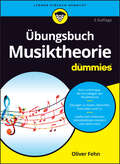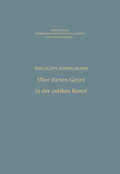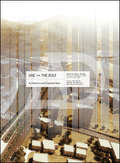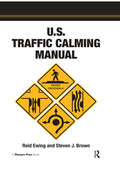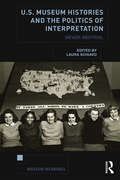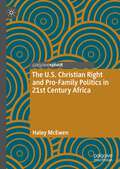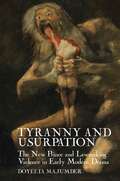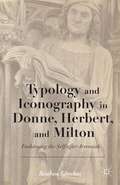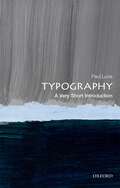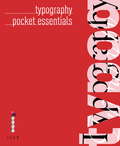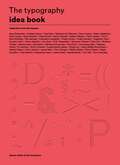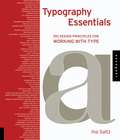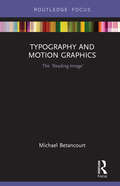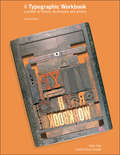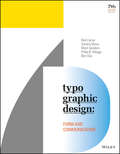- Table View
- List View
Übungsbuch Musiktheorie für Dummies (Für Dummies)
by Oliver FehnWenn der Stoff sitzen soll, muss man die Theorie auch mal praktisch angehen. Denn auch bei der Musiktheorie hilft vor allem Üben, Üben, Üben. Dieses Buch enthält abwechslungsreiche Übungen, kurzweilige Multiple-Choice-Tests, hilfreiche Eselsbrücken und viele Tipps und Tricks, die Ihnen helfen, Ihr musiktheoretisches Wissen zur Perfektion zu bringen. Sie finden kompakte Erklärungen der wichtigsten musiktheoretischen Grundlagen und natürlich ausführliche Lösungen zu den zahlreichen Übungen. Viele der Übungen und Lösungen gibt es außerdem zum Anhören als Download. Sie erfahren Wie Sie Ihr musiktheoretisches Wissen durch Übungen zu Noten, Akkorden, Intervallen, Tonleitern, Tonarten und Co. vertiefen Wie Sie Musik notieren und spielen Wie Sie Ihr Lieblingsstück in eine andere Tonart transponieren
Ubiquitous Computing and Multimedia Applications: Second International Conference, UCMA 2011, Daejeon, Korea, April 13-15, 2011. Proceedings, Part I (Communications in Computer and Information Science #150)
by Tai-Hoon Kim Hojjat Adeli Rosslin John Robles Maricel BalitanasThis two-volume set (CCIS 150 and CCIS 151) constitutes the refereed proceedings of the Second International Conference on Ubiquitous Computing and Multimedia Applications, UCMA 2011, held in Daejeon, Korea, in April 2011. The 86 revised full papers presented were carefully reviewed and selected from 570 submissions. Focusing on various aspects of advances in multimedia applications and ubiquitous computing with computational sciences, mathematics and information technology the papers present current research in the area of multimedia and ubiquitous environment including models and systems, new directions, novel applications associated with the utilization, and acceptance of ubiquitous computing devices and systems.
Ubiquitous Computing and Multimedia Applications: Second International Conference, UCMA 2011, Daejeon, Korea, April 13-15, 2011. Proceedings, Part II (Communications in Computer and Information Science #151)
by Tai-Hoon Kim Hojjat Adeli Rosslin John Robles Maricel BalitanasThis two-volume set (CCIS 150 and CCIS 151) constitutes the refereed proceedings of the Second International Conference on Ubiquitous Computing and Multimedia Applications, UCMA 2011, held in Daejeon, Korea, in April 2011. The 86 revised full papers presented were carefully reviewed and selected from 570 submissions. Focusing on various aspects of advances in multimedia applications and ubiquitous computing with computational sciences, mathematics and information technology the papers present current research in the area of multimedia and ubiquitous environment including models and systems, new directions, novel applications associated with the utilization, and acceptance of ubiquitous computing devices and systems.
Über Projektionen: Von der Rekonstruktion zur Dekonstruktion, von der Konvention zur Alternative (Image #147)
by Julia Mia Stirnemann»Über Projektionen« gibt Einsichten in Weltkarten, ihre Darstellungsweisen und den damit verbundenen Weltanschauungen. Die Projektion wird dabei einerseits als ideelle Projektion im Sinne einer Weltanschauung dargelegt, die vorherrschende Vorstellungsbilder, Wertmaßstäbe, Ordnungsprinzipien, Denkweisen oder Erklärungsmodelle der Welt beschreibt. Andererseits wird auf die geometrische Projektion, die Weltkarten zugrunde liegt, fokussiert: Jede Weltkarte steht vor der Schwierigkeit, die Kugeloberfläche in einer zweidimensionalen Ebene darzustellen. In einer Rekonstruktion werden anhand von Weltkarten verschiedene paradigmatische Weltanschauungen aufgezeigt. In einer Dekonstruktion sind konventionelle durch alternative Weltkarten kontrastiert. Die breite Vielfalt an möglichen Weltkarten zeigt, dass Weltkarten keinen Status quo abbilden, sondern lediglich eine subjektive Interpretation der Welt zu einem bestimmten Zeitpunkt sind, die ständigen Umbrüchen unterworfen bleiben.
Über Hirten-Genre in der antiken Kunst (Abhandlungen der Rheinisch-Westfälischen Akademie der Wissenschaften #65)
by Nikolaus HimmelmannÜber Form und Struktur – Geometrie in Gestaltungsprozessen
by Cornelie LeopoldFormen und Strukturen werden als grundlegende Gestaltungsrelationen, insbesondere in Architektur und Produktdesign, untersucht. Die Autoren aus unterschiedlichen Disziplinen gehen der Frage nach, welche Rolle die Geometrie bei Formbildungsprozessen spielt. Traditionell kommt der Geometrie die Aufgabe zu, Formen erfassbar, darstellbar und umsetzbar zu machen, deren Erzeugungsregeln zu untersuchen. Die aktuellen Entwicklungen zeigen die Verwendung immer komplexerer, unregelmäßigerer und scheinbar "ungeometrischer" Formen. Neben geometrischen und topologischen Betrachtungen werden systemtheoretische Überlegungen sowie Prozesse der Morphogenese den Gestaltungen zugrunde gelegt. Die Autoren thematisieren Bezüge zwischen Form, Struktur und Materialität und wenden sich damit gegen aktuelle Tendenzen einer Beliebigkeit der Gestaltung. Ingenieurwissenschaftliche und künstlerisch-ästhetische Gestaltungsansätze finden zusammen. Die Bedeutung mathematisch-strukturellen und geometrischen Denkens in diesen komplexen Zusammenhängen werden sowohl in historischem Kontext beleuchtet als auch in computerbasierten Arbeitsprozessen in realisierten Beispielen aus der Praxis aufgezeigt.
Über die Grenzen des Bildes: Kulturelle Differenz und transkulturelle Dynamik im globalen Feld der Kunst (Image #174)
by Birgit MersmannIm globalisierten Vernetzungsraum der Kunstsphäre befinden sich bildkulturelle Grenzen zwischen nationalen und regionalen Künsten zunehmend in Auflösung. Wo lassen sich Grenzverschiebungen im globalen Feld moderner und zeitgenössischer Kunst orten? Durch welche differenziellen Sicht- und Darstellungsweisen werden Abgrenzungen markiert und Bildkulturkonflikte befördert? In welchen Kontaktzonen und unter welchen Kulturtransferbedingungen bilden sich transkulturelle Dynamiken heraus? Aus der Perspektive kulturwissenschaftlicher Bildforschung erkundet Birgit Mersmann Grenzziehungen, Grenzverhandlungen und Grenzüberschreitungen zwischen westlicher, asiatischer und arabischer Bildkunst.
Über den Zusammenhang von Unternehmenskultur und Architektur: Denkanstöße für Architekten, Manager und Bauherren (essentials)
by Thomas Habscheid-Führer Christian J. GrothausDie Autoren bieten in diesem essential eine kleine Reise durch die Ideen der Architekturgeschichte, die hinter der klassischen Moderne, der Postmoderne und dem architektonischen Strukturalismus stecken. Sie führen Soziologie, Architektur und Organisationstheorie zusammen mit dem Ziel, die Prämissen von Gebäuden zu erläutern, die Wissen vermehren. Die Autoren plädieren dafür, im Gebäude eine „situative Identität“ zu stiften. Dieses Konzept führt die herkömmliche, markenfixierte „Corporate Architecture“ weiter und beschreibt eine Gebäude-Performanz, die der Mitarbeiterschaft ein kooperatives und vernetztes Arbeiten erleichtert – aber nicht verordnet von oben nach unten, sondern umgekehrt. Eine lebendige und individuelle Unternehmensarchitektur zeigt sich nur, wenn sie gleichermaßen in Organisationsprozessen wie räumlichen Ausprägungen virulent ist.
UAE and the Gulf: Architecture and Urbanism Now (Architectural Design)
by George Katodrytis Kevin MitchellAt the end of the 20th century, Dubai attracted international media attention as the world sought to make sense of the city’s extraordinary growth. Exuberant projects such as the Burj Arab, the Burj Khalifa and the Palm Islands attracted investment in dreams to transform the region. While the global financial crisis kept dreams from becoming reality, this issue of AD seeks to present a view of architecture and urbanism in the United Arab Emirates (UAE) and other states in the wider Gulf Cooperation Council (GCC) at a time when greater economic stability promises new beginnings. The issue presents examples of architecture that transcends preoccupation with fabricating images, and traces the process of making contemporary Gulf cities, from material tectonics to large-scale masterplans. By presenting the architecture of UAE and the Gulf within the context of broader regional developments and global trends, it highlights how projects in the UAE, Qatar, Kuwait and Saudi Arabia have contributed to unprecedented urban growth, while emphasising the continuing environmental challenges of building in the region. In addition to highlighting various sustainable initiatives intended to counteract these challenges, the issue also explores how computational design and new technologies are being innovatively employed to mitigate the impact of arid climates. Contributors include: Ameena Ahmadi, Kelly Hutzell, Varkki Pallathucheril, Todd Reisz, Rami el Samahy, Terri Meyer Boake, Jeffrey Willis. International architects: Foster + Partners, Frank Gehry, HOK, IM Pei, Legoretta + Legoretta, Jean Nouvelle, Reiser + Umemoto, Allies and Morrison. Regional architects: AGi (Kuwait), DXB.lab (UAE), X Architects (UAE).
U.S. Traffic Calming Manual
by Reid EwingA comprehensive how-to manual for traffic calming in the United States. Planners and engineers can look to this manual for guidance on the appropriate use, design, and signing and marking of traffic-calming measures. For local officials, developers, and community associations, it is an introduction to the goals and tactics of traffic calming. Based in part on the first traffic-calming manual taken through a formal rule-making process and adopted by a state department of transportation as a supplement to its roadway design manual, this book catalogs principles that have been modified by many local jurisdictions to match local priorities and preferences. Standardization is key to the success of traffic-calming initiatives, and this book explains the processes, tools, and design needed to create a standard traffic-calming program. It also shows how municipalities can build needed flexibility into such programs. Signage and markings are also key, and a chapter is devoted to these issues. This is the book that states and municipalities need to create effective traffic-calming programs.
U.S. Traffic Calming Manual
by Reid EwingA comprehensive how-to manual for traffic calming in the United States. Planners and engineers can look to this manual for guidance on the appropriate use, design, and signing and marking of traffic-calming measures. For local officials, developers, and community associations, it is an introduction to the goals and tactics of traffic calming. Based in part on the first traffic-calming manual taken through a formal rule-making process and adopted by a state department of transportation as a supplement to its roadway design manual, this book catalogs principles that have been modified by many local jurisdictions to match local priorities and preferences. Standardization is key to the success of traffic-calming initiatives, and this book explains the processes, tools, and design needed to create a standard traffic-calming program. It also shows how municipalities can build needed flexibility into such programs. Signage and markings are also key, and a chapter is devoted to these issues. This is the book that states and municipalities need to create effective traffic-calming programs.
U.S. Museum Histories and the Politics of Interpretation: Never Neutral (Museum Meanings)
by Laura SchiavoU.S. Museum Histories and the Politics of Interpretation is the first collection to examine the history of museums in the United States through the lens of the political and ideological underpinnings at the heart of exhibitions, collecting, and programming.Including contributions from historians, art historians, anthropologists, academics, and museum professionals, the book argues that museums have always been embedded in the politics and culture of their time – whether that means a reification of hegemonic notions of race, gender, and progress or a challenge to those normative structures. Contributions probe the political nature of collection and interpretation as concept and practice, and museum work as both reflective of and contributing to the politics and circulation of power in different historical moments. As a whole, the volume provides detailed readings of museums that demonstrate the ways in which these trusted cultural institutions have intervened in shifting concepts of nation, community, indigeneity, race, citizenship, inclusion, identity, localism, and memory.U.S. Museum Histories and the Politics of Interpretation makes arguments about the historically and politically rooted nature of cultural production in museums that apply to institutions across the globe. It is essential reading for students and scholars of museum studies, public history, cultural history, art history, and memory.
U.S. Museum Histories and the Politics of Interpretation: Never Neutral (Museum Meanings)
U.S. Museum Histories and the Politics of Interpretation is the first collection to examine the history of museums in the United States through the lens of the political and ideological underpinnings at the heart of exhibitions, collecting, and programming.Including contributions from historians, art historians, anthropologists, academics, and museum professionals, the book argues that museums have always been embedded in the politics and culture of their time – whether that means a reification of hegemonic notions of race, gender, and progress or a challenge to those normative structures. Contributions probe the political nature of collection and interpretation as concept and practice, and museum work as both reflective of and contributing to the politics and circulation of power in different historical moments. As a whole, the volume provides detailed readings of museums that demonstrate the ways in which these trusted cultural institutions have intervened in shifting concepts of nation, community, indigeneity, race, citizenship, inclusion, identity, localism, and memory.U.S. Museum Histories and the Politics of Interpretation makes arguments about the historically and politically rooted nature of cultural production in museums that apply to institutions across the globe. It is essential reading for students and scholars of museum studies, public history, cultural history, art history, and memory.
The U.S. Christian Right and Pro-Family Politics in 21st Century Africa
by Haley McEwenThis book will address and uncover the role of US Christian Right ‘pro-family’ groups in mobilizing counter-movements against LGBTIQ+ human rights, reproductive justice, and sexuality education in Africa, and will intervene in the tendency to exceptionalize Africa as a ‘homophobic continent’ following the surge in homophobic and transphobic legislation, hate speech, and violence in recent years. The author employs the lens of decoloniality in an intersectional manner to unpack the multiple forms of hierarchy and oppression that the concept of the nuclear family has historically worked to naturalize in the interests of capitalism, Christo-normativity, and a world system dominated and controlled by the global north. Proceeding from the historical geopolitical context informing nuclear family idealization, the analysis then presents a critical discussion of contemporary pro-family discourses, showing that pro-family narratives that universalize and politicize the notion of ‘family’ are not only constituting agendas that erode LGBTIQ+ and reproductive justice, but reinforce an international order that privileges Euro-American interests despite pro-family claims that their agendas are anti-imperialist. This book will be of interest to scholars in gender, sexuality, and queer studies; postcolonial studies; and international relations.
Tyranny and Usurpation: The New Prince and Lawmaking Violence in Early Modern Drama (English Association Monographs: English at the Interface #5)
by Doyeeta MajumderIn the middle years of the sixteenth century, English drama witnessed the emergence of the ‘tyrant by entrie’ or the usurper, who supplanted earlier ‘tyrant by the administration’ as the main antihero of political drama. This usurper or, in Machiavellian terms principe nuove, was the prince without dynastic claims who creates his sovereignty by dint of his own ‘virtù’ and through an act of ‘lawmaking’ violence. Early Tudor morality plays were exclusively concerned with the legitimate monarch who becomes a tyrant; in the political drama of the first half of the sixteenth century, we do not encounter a single instance of usurpation among the texts that are still available to us. In contrast, the historical and tragic plays of the late Elizabethan and Jacobean periods teem with illegitimate monarchs. Almost all of Shakespeare’s history plays, at least four of his ten tragedies, and even a few of his comedies feature usurpation or potential usurpation of sovereign power as a crucial plot device. Why and how does usurpation emerge as a preoccupation in English theatre? What are the political, historical, legal, and dramaturgical transformations that influence and are influenced by this moment of emergence? As the first book-length study devoted exclusively to the study of usurpation and tyranny in sixteenth-century drama and politics, Tyranny and Usurpation: The New Prince and Lawmaking Violence will challenge existing disciplinary boundaries in order to engage with these critical questions.
Typology and Iconography in Donne, Herbert, and Milton: Fashioning the Self after Jeremiah
by Reuben SánchezThis book analyzes the iconographic traditions of Jeremiah and of melancholy to show how Donne, Herbert, and Milton each fashions himself after the icons presented in Rembrandt's Jeremiah Lamenting the Destruction of Jerusalem , Sluter's sculpture of Jeremiah in the Well of Moses, and Michelangelo's fresco of Jeremiah in the Sistine Chapel.
Typography: A Very Short Introduction (Very Short Introductions)
by Paul LunaTypography, the art of designing printed words, was once the domain of an elite few artists but has become an area with which millions of people engage daily. The widespread usage of digital devices from laptops to tablets and smart phones which are used for written communications means that we are regularly asked to make decisions about the fonts, sizes, and layouts we use in our writing. This broadening engagement with the field of typography has led to a perceptible shift from debates about legibility and technicalities to conversations about which fonts best reflect the writer's personality or style . In this Very Short Introduction, Paul Luna offers a broad definition of typography as design for reading, whether in print or on screens, where a set of visual choices are taken to make a written message more accessible, more easily transmitted, more significant, or more attractive. Considering the development of letterforms and the shapes of letter we use, Luna discusses the history behind our modern day letters and fonts, before considering the issues behind key typographic decisions, and the differences between printed and on-screen typography. Presenting any piece of typography as a fundamental design choice, Luna introduces the options available today, and explores the reasons why key typographic decisions are made. ABOUT THE SERIES: The Very Short Introductions series from Oxford University Press contains hundreds of titles in almost every subject area. These pocket-sized books are the perfect way to get ahead in a new subject quickly. Our expert authors combine facts, analysis, perspective, new ideas, and enthusiasm to make interesting and challenging topics highly readable.
Typography: A Very Short Introduction (Very Short Introductions)
by Paul LunaTypography, the art of designing printed words, was once the domain of an elite few artists but has become an area with which millions of people engage daily. The widespread usage of digital devices from laptops to tablets and smart phones which are used for written communications means that we are regularly asked to make decisions about the fonts, sizes, and layouts we use in our writing. This broadening engagement with the field of typography has led to a perceptible shift from debates about legibility and technicalities to conversations about which fonts best reflect the writer's personality or style . In this Very Short Introduction, Paul Luna offers a broad definition of typography as design for reading, whether in print or on screens, where a set of visual choices are taken to make a written message more accessible, more easily transmitted, more significant, or more attractive. Considering the development of letterforms and the shapes of letter we use, Luna discusses the history behind our modern day letters and fonts, before considering the issues behind key typographic decisions, and the differences between printed and on-screen typography. Presenting any piece of typography as a fundamental design choice, Luna introduces the options available today, and explores the reasons why key typographic decisions are made. ABOUT THE SERIES: The Very Short Introductions series from Oxford University Press contains hundreds of titles in almost every subject area. These pocket-sized books are the perfect way to get ahead in a new subject quickly. Our expert authors combine facts, analysis, perspective, new ideas, and enthusiasm to make interesting and challenging topics highly readable.
Typography Pocket Essentials: The History and Principles of the Art
by Alistair Dabbs Alastair CampbellTypography is the most ubiquitous of the graphic arts, with all of us now having access to innumerable fonts and the typographic tools that can, in the right hands, lift any text from the mundane to the beautiful.Opening with an overview of the history of the art, Typography Pocket Essentials introduces the key principles and techniques of typography, and presents 200 of the most useful and important fonts, making it a handy primer and essential reference guide all rolled into one.- Learn the rich history of the art, from Gutenberg to Neville Brody and beyond- Master the principles of effective typography and create beautiful documents yourself- 200 key fonts are profiled for easy reference and rapid selection
The Typography Idea Book: Inspiration from 50 Masters
by Gail Anderson Gaile Anderson Steven HellerThe latest in this successful series, this book features around 150 of the most important buildings in the history of world architecture – from the pyramids and Parthenon to some of the most significant works by recent architects. The buildings are organized by type – from places of worship and public buildings to houses – and are divided into nine chapters, each with an informative introduction that surveys the history of that type. For each building there are numerous, accurate scale drawings showing a combination of floor plans, elevations and sections as appropriate, all specially redrawn for this book. The quality and number of the line drawings, together with the authoritative text by a renowned architectural historian, allow all the buildings to be understood in detail and make this an invaluable resource for students.
Typography Essentials (PDF)
by Ina SaltzTypography Essentials is a practical, hands-on resource to distill, organize, and compartmentalize—but not to oversimplify—the many complex issues surrounding the effective use of typography. It is for designers of every medium in which type plays a major role. A deep understanding of letterforms and knowledge of the effective use of letterforms can only be obtained with constant observation and experimentation; it evolves over a lifetime of design practice and study. This book is intended to advance the progress of designers seeking to deepen their typographic expertise; it is organized and designed to make the process enjoyable and entertaining, as well as instructional.This book is divided into four easy-to-use sections: The Letter, The Word, The Paragraph, and The Page. Each of the 100 principles has an explanation and examples representing the principle in action.
Typography and Motion Graphics: The 'Reading-Image'
by Michael BetancourtIn his latest book, Michael Betancourt explores the nature and role of typography in motion graphics as a way to consider its distinction from static design, using the concept of the ‘reading-image’ to model the ways that motion typography dramatizes the process of reading and audience recognition of language on-screen. Using both classic and contemporary title sequences—including The Man With the Golden Arm (1955), Alien (1979), Flubber (1998), Six Feet Under (2001), The Number 23 (2007) and Scott Pilgrim vs. The World (2010)—Betancourt develops an argument about what distinguishes motion graphics from graphic design. Moving beyond title sequences, Betancourt also analyzes moving or kinetic typography in logo designs, commercials, film trailers, and information graphics, offering a striking theoretical model for understanding typography in media.
Typography and Motion Graphics: The 'reading-image' (Routledge Studies In Media Theory And Practice Ser.)
by Michael BetancourtIn his latest book, Michael Betancourt explores the nature and role of typography in motion graphics as a way to consider its distinction from static design, using the concept of the ‘reading-image’ to model the ways that motion typography dramatizes the process of reading and audience recognition of language on-screen. Using both classic and contemporary title sequences—including The Man With the Golden Arm (1955), Alien (1979), Flubber (1998), Six Feet Under (2001), The Number 23 (2007) and Scott Pilgrim vs. The World (2010)—Betancourt develops an argument about what distinguishes motion graphics from graphic design. Moving beyond title sequences, Betancourt also analyzes moving or kinetic typography in logo designs, commercials, film trailers, and information graphics, offering a striking theoretical model for understanding typography in media.
A Typographic Workbook: A Primer to History, Techniques, and Artistry
by Kate Clair Cynthia Busic-SnyderLavishly illustrated with more than 450 images, A Typographic Workbook, Second Edition explains the process successful designers use to select, space, and creatively integrate fonts. This essential text demonstrates the use of type as a dynamic and expressive communication tool. This edition provides new and updated coverage of a broad range of topics–from a logical, clear historical overview of the craft to the latest digital technologies. Known for its highly interactive format, this Second Edition continues to include helpful review questions and multiple-choice quizzes, as well as many new projects and skill-building exercises that help readers immediately apply what they have learned. A Typographic Workbook, Second Edition is a valuable professional resource for working designers and an indispensable training tool for graphic design students.
Typographic Design: Form and Communication
by Rob Carter Sandra Maxa Mark Sanders Philip B. Meggs Ben DayThe bestselling introduction to designing the written word Typographic Design: Form & Communication is the definitive reference for graphic designers, providing a comprehensive introduction to the visual word. Done well, typopgraphy can communicate so much more than the words themselves. Typographic design determines how you feel about a message, the associations you make, and ultimately, the overall success of the communication. Typographic design extends from the page to the screen, and is a critical element of almost any graphic design project. This book provides essential guidance on everything related to type: from letterforms and negative space, to messaging, processes, and history, aspiring designers will find great utility in mastering these critical concepts. This new seventh edition has been fully updated with new coverage of contemporary typography processes, updated case studies, and new examples from branding, print, web, motion, and more. On-screen typographic design concepts are discussed in greater detail, and the online supplemental materials include new flashcards, terminology and quizzes. Understand design factors as they relate to type Explore communication and typographic messaging Learn how typography has evolved, and where it is headed Adopt established approaches to designing with type The irony of typographic design is that, when done well, it often goes unnoticed—but its impact on a project’s overall success is undeniable. Typography can make or break a page, can enhance or overpower an image, and can obscure a message or bring it into sharp focus. It is one of the most powerful tools in the graphic designer’s arsenal, and Typographic Design is the complete, practical introduction.
